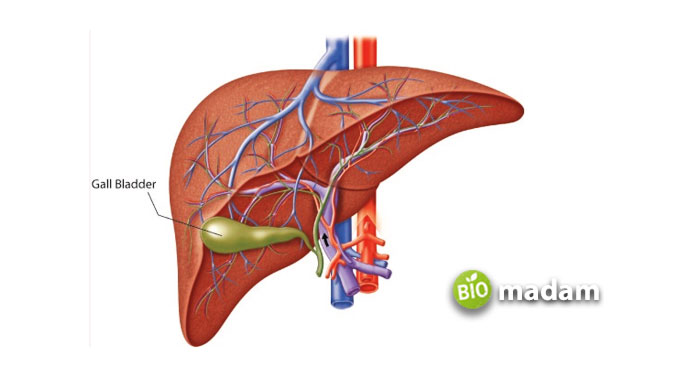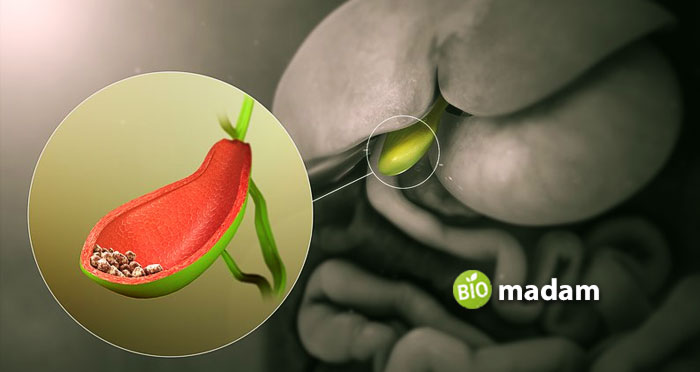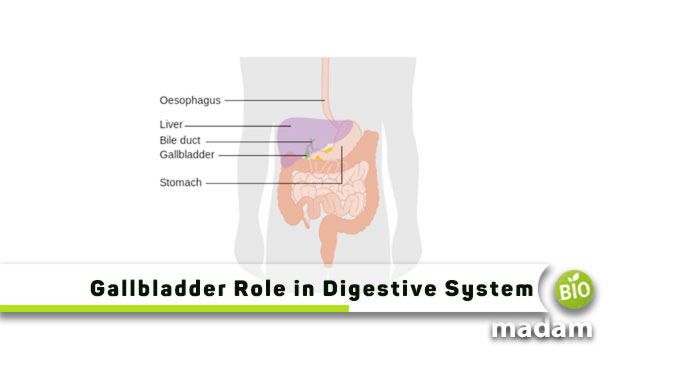The gallbladder is a small, sac-like organ on the right side of the abdomen, just beneath the liver. It is approximately 3-4 inches long and can hold about 50 milliliters (about 2 ounces) of bile. The gallbladder has a muscular wall that allows it to contract and release bile as needed.
The gallbladder comprises epithelial and connective tissues. The inner lining of the gallbladder is composed of simple columnar epithelial cells. It is surrounded by a layer of connective tissue, which gives the organ its shape and strength. The cystic artery, a branch of the right hepatic artery supplies blood to the gallbladder. Alternatively, the cystic vein carries blood away from the gallbladder and into the liver.
Keep reading to learn the functions of the gallbladder.
Functions of Gallbladder
Your gallbladder is a part of the digestive system and plays an important role in digestion. Some of these roles include:
Bile Production and Release
The gallbladder releases bile when needed in response to the hormones secretin and CCK. The bile then emulsifies fats in the small intestine, allowing for better absorption of nutrients. Bile is essential for absorbing fat-soluble vitamins such as A, D, E, and K. These vitamins are dissolved in the bile and can be absorbed in the small intestine.
The bile produced by the liver flows into the gallbladder through the hepatic duct and then is stored there until it is needed for digestion. It is a yellowish-green fluid composed of bile salts, cholesterol, and pigments. It helps emulsify fats, making them easier to digest. When food is in the intestines, the gallbladder contracts and releases bile into the small intestine via the common bile duct connected to the liver and the pancreas. The cystic duct connects the gallbladder to the common bile duct. This duct carries bile from the gallbladder to the common bile duct, which then carries it to the small intestine.
Storage
The gallbladder serves as a reservoir for bile, allowing the liver produce bile at a steady rate throughout the day. The gallbladder can hold up to 50 milliliters of bile, which is released into the small intestine as needed. This allows the liver to conserve energy and resources by not having to produce bile constantly. Diseases and disorders of the gallbladder may lead to issues in bile storage.

pH Regulation
The gallbladder also helps to regulate the pH of bile, making it more alkaline when needed. This helps neutralize the stomach acid that enters the small intestine with the food, preventing damage to the intestinal lining. It makes the environment in the small intestine more suitable for the action of enzymes and other digestive juices, allowing for better absorption of macro and micronutrients.
Cholesterol and Bilirubin Excretion
The gallbladder also plays a role in helping the body excrete excess cholesterol and bilirubin. The liver produces bile containing these substances. But, if they are not needed for digestion, the gallbladder will store them until they can be eliminated from the body.
Gallstone Prevention
Bile comprises water, electrolytes, bile acids, and cholesterol. Sometimes, the bile can become too concentrated, leading to the formation of gallstones. The gallbladder helps to prevent the formation of gallstones by releasing bile in small amounts as needed and regulating the pH of bile.
Helping other Organs
The biliary tract connects your gallbladder to the rest of your digestive system via a network of exocrine glands called the bile ducts. The biliary tract (also known as the biliary system or biliary tree) is a pipe-like structure that transports bile from the liver to the small intestine.
Gallbladder Malfunctions
In some cases, the gallbladder may not function properly. Despite this, the liver acts as a gland to produce bile, which flows directly into the small intestine. The absence of a gallbladder does not cause significant changes in the digestion process. Some of the issues of the gallbladder include:
Gallstones
One common problem is gallstones, which are hard, pebble-like deposits that can form in the gallbladder. These can block the flow of bile, causing pain and inflammation. In such cases, surgery to remove the gallbladder may be necessary.

Cholecystitis & Cholangitis
Cholecystitis is gallbladder inflammation, and cholangitis refers to the inflammation of the bile ducts that can also occur due to gallbladder dysfunction.
Gallstone Pancreatitis
Gallstone pancreatitis is pancreatic inflammation. It happens when a gallstone moves down the common bile duct and plugs the pancreatic duct right before it drains into the small intestine.
Cancer
Gallbladder cancer is uncommon. Yet, you may get discomfort in the right upper quadrant of your abdomen. It is considerably more likely that another ailment causes this discomfort. Inflammation, family history, and age are common causes of cancer.
The Bottom Line
The gallbladder plays a vital role in the digestive system by storing and concentrating bile, which is necessary for the digestion and absorption of fats and fat-soluble vitamins. It also helps regulate the pH of bile, excrete excess cholesterol and bilirubin and serves as a reserve for bile. Proper function of the gallbladder is important for maintaining the overall health of the digestive system, and any dysfunction should be addressed by a medical professional.
FAQs
What happens if gallbladder is removed?
Often people have to get their gallbladder removed due to gallbladder stones or another anomaly. However, you must not be worried if you have to get your bladder removed surgically. You can lead a normal life and your liver will produce bile required to digest your food.
What are the 4 main functions of the gallbladder?
The gallbladder performs various functions that include storing and concentrating bile and controlling its flow into the small intestine. It also regulates the composition of bile and responds to intestinal hormones.
Why gallbladder is damaged?
Often concentrated or thickened bile can lead to cholecystitis by blocking the bile duct. Scarring in the bile ducts may also cause blockage besides bacterial and viral infections.

Anna has completed her degree in Pharmacy from the University of Hawaii. She is serving as a research assistant in a pharmaceutical company. She had a great interest in writing blogs, traveling to different parts of the US, and trying delicious recipes in her spare time.

